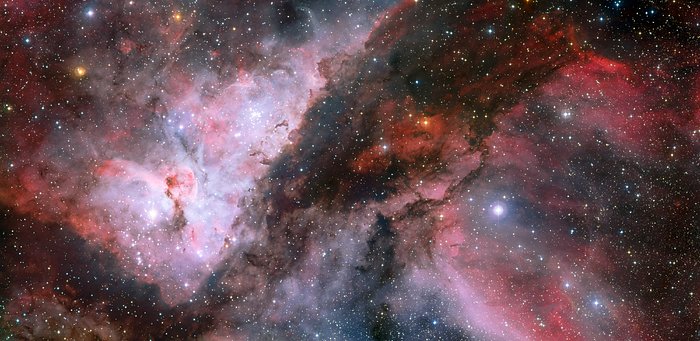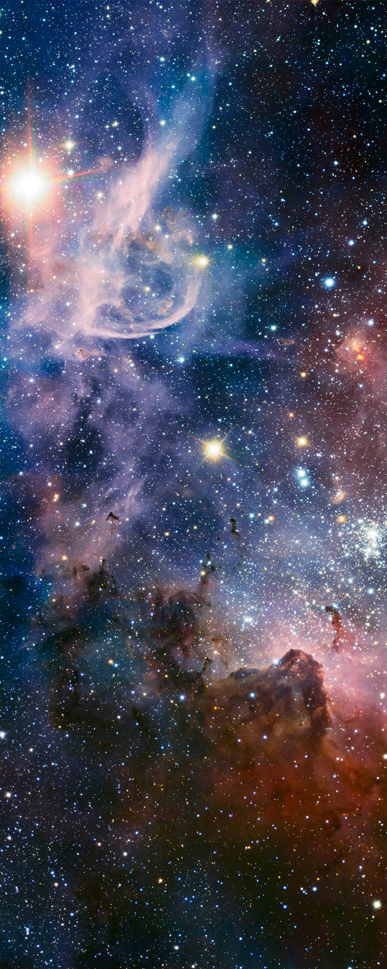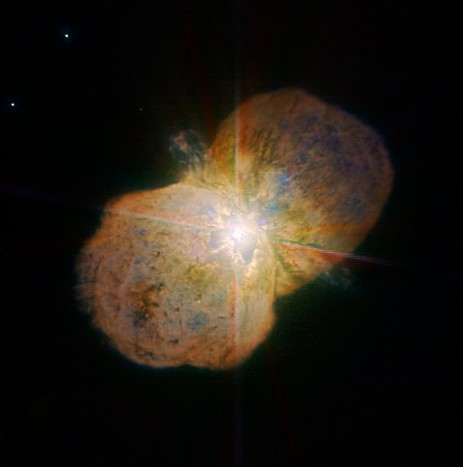Eta Carinae
Nebulosa della Carena
Nebulosa della Carena
Questa immagine composita a colori della Nebulosa della Carena, rivela dettagli raffinati di stelle e della regione di polveri. In questa fotografia ad ampio campo si possono notare diversi oggetti astronomici: in alto a sinistra dell'immagine è una delle più imponenti stelle binarie nell'Universo, Eta Carinae, con la famosa Nebulosa "Buco della Serratura" proprio adiacente alla stella. Un gruppo molto luminoso di giovani stelle sotto e a destra di Eta Carinae: è l'ammasso aperto Trumpler 14. Anche un secondo ammasso stellare aperto, Collinder 228 lo si può notare appena al di sotto Eta Carinae. Per sapere di più...
Carina Nebula
Colour-composite image of the Carina Nebula, revealing exquisite details in the stars and dust of the region. Several well known astronomical objects can be seen in this wide field image : above left of the image there's one of the most impressive binary stars in the Universe, Eta Carinae, with the famous Keyhole Nebula just adjacent to the star. The collection of very bright, young stars bottom and to the right of Eta Carinae is the open star cluster Trumpler 14. A second open star cluster, Collinder 228 is also seen in the image, just below Eta Carinae. More info...
Eta Carinae
Eta Carinae è un sistema stellare di almeno due stelle che sommata la loro luminosità supera 5 milioni di volte quella del Sole, distante circa 7.500 anni luce nella costellazione della Carena. La prima registrazione come una stella di 4 ° magnitudine, nel periodo 1837-1856 si illuminò notevolmente durante un evento noto come la "Grande Eruzione". Eta Carinae è diventata la seconda-stella più luminosa del cielo tra il 11 e il 14 marzo 1843, prima di svanire ben al di sotto di visibilità a occhio nudo. Il sistema è fortemente oscurato dalla nebulosa "Omuncolo", materiale espulso dal sistema durante la Grande Eruzione. Eta Carinae è un membro del cluster aperto Trumpler 16 all'interno della molto più grande Nebulosa della Carena. Per saperne di più...
Eta Carinae
Eta Carinae is a stellar system containing at least two stars with a combined luminosity over five million times that of the Sun, located around 7500 light-years (2300 parsecs) distant in the constellation Carina. First recorded as a 4th-magnitude star, it brightened considerably over the period 1837 to 1856 in an event known as the Great Eruption. Eta Carinae became the second-brightest star in the sky between 11 and 14 March 1843 before fading well below naked eye visibility. The system is heavily obscured by the Homunculus Nebula, material ejected from the primary during the Great Eruption. It is a member of the Trumpler 16 open cluster within the much larger Carina Nebula.

Stelle binarie
Si definisce stella binaria un sistema stellare formato da due stelle che orbitano intorno al loro comune centro di massa; la stella più luminosa viene chiamata primaria, mentre l'altra viene chiamata compagna o secondaria. Il termine stella doppia è a volte utilizzato quale sinonimo di stella binaria, ma talvolta indica sia le stelle binarie fisicamente legate fra loro sia le binarie ottiche, ovvero coppie di stelle che appaiono vicine se osservate dalla Terra, ma che non hanno alcun legame gravitazionale fra loro. Per saperne di più...
A binary star is a star system consisting of two stars orbiting around their common barycenter. Systems of two or more stars are called multiple star systems. The term double star is often used synonymously with binary star; however, double star can also mean optical double star. Optical doubles are so called because the two stars appear close together in the sky as seen from the Earth; they are almost on the same line of sight. Nevertheless, their "doubleness" depends only on this optical effect; the stars themselves are distant from one another and share no physical connection. More info...
Eta Carinae - Credits: ESO/G. ESO's Very Large Telescope
Sistema Solare Interno Mercurio Venere Terra | Sistema Solare Esterno | Via Lattea | Universo Supernova Extragalattiche |
Prenota la mostra per i tuoi eventi (da novembre 2017) | |||



































